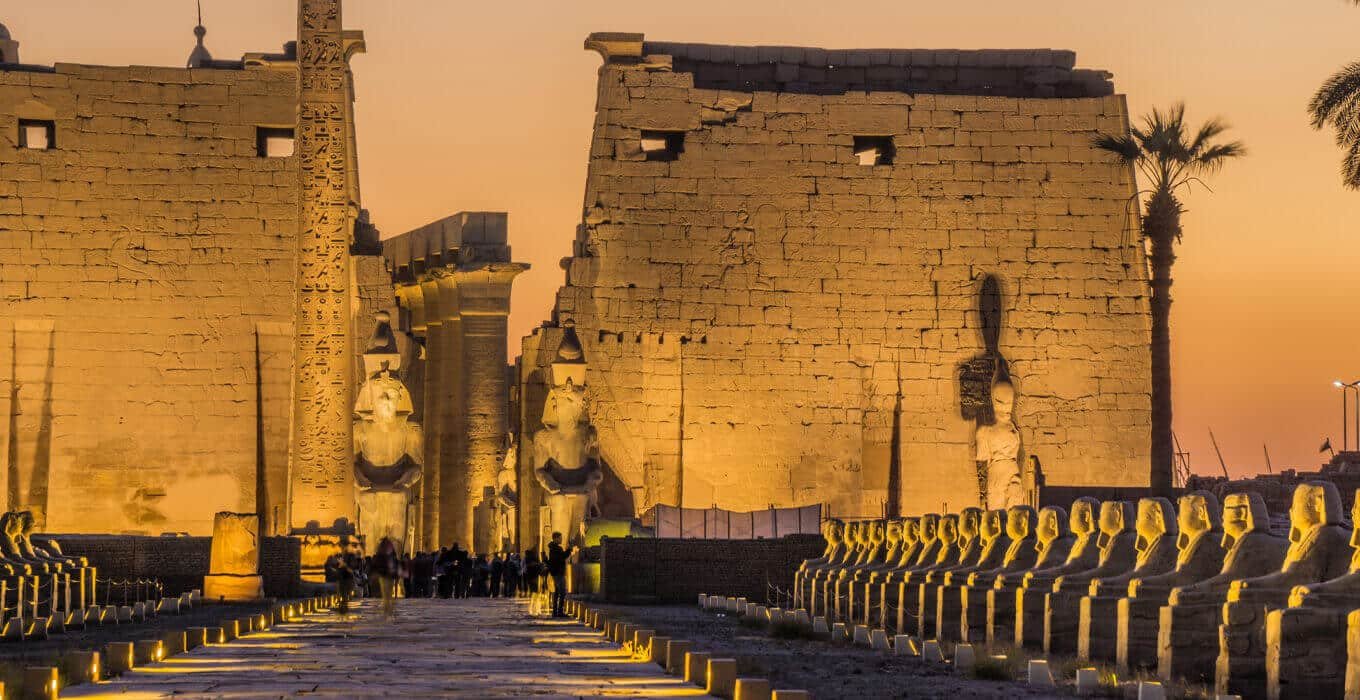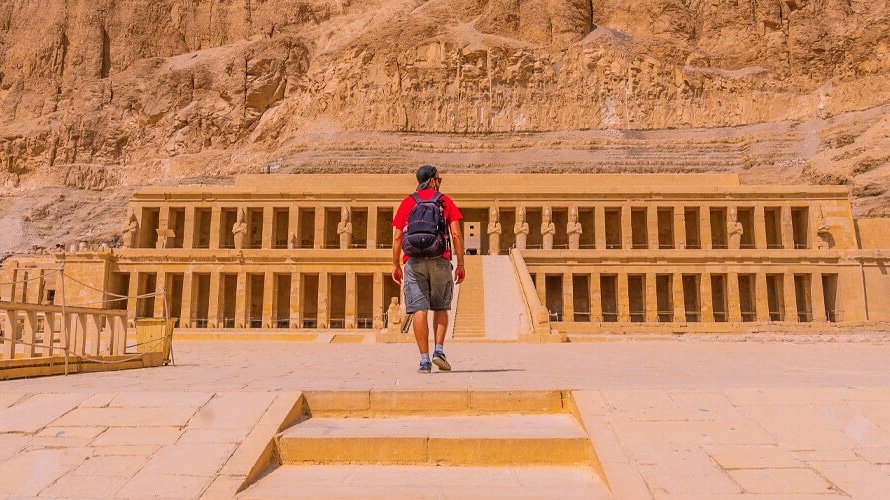The Temple of Luxor, located on the East Bank of the Nile River in Luxor, Egypt, stands as a magnificent testament to the power and artistry of ancient Egyptian civilization. This sprawling complex wasn’t merely a house of worship dedicated to the god Amun; it was a vibrant stage where grand festivals played out, pharaohs asserted their divine connection, and the very rhythm of the cosmos was reaffirmed. Built over centuries, this temple’s stones tell tales of ambition, faith, and the enduring spirit of an extraordinary civilization.
In this article, we’ll delve into the Temple of Luxor’s rich history, exploring its architectural wonders that symbolize the power of the pharaohs. We’ll uncover the secrets of ancient festivals that came alive within its walls. And to fully enhance your experience, we’ll provide practical travel tips to help you plan your own unforgettable visit to this marvel of ancient Egypt.
Temple of Luxor: A Historical Tapestry
The Temple of Luxor is not the product of a single mind, but a magnificent tapestry woven through centuries. Each era left its imprint, creating the layered and fascinating complex we marvel at today. Let’s unravel the threads of its history:
Amenhotep III and the Temple’s Foundation
Amenhotep III, known as the “Dazzling Sun King,” ruled during the New Kingdom, a golden age of wealth and power for Egypt. Possessed with grand ambition, he envisioned the Temple of Luxor as a glorious tribute to the Theban Triad: Amun (the king of gods), his wife Mut, and their son Khonsu (the moon god). Its construction reflected Amenhotep III’s desire to solidify his connection to the divine and enhance his own status as a living god on earth.
Ramses II: Expansion and Grandeur
Ramses II, arguably Egypt’s most prolific builder, couldn’t resist adding his own grand flourishes to the Temple of Luxor. Renowned for his military conquests and larger-than-life ego, he commissioned enormous pylons (gateways), towering statues of himself, and the majestic First Court. Of course, one obelisk wasn’t enough – he erected a pair at the entrance. Today, only one remains in Luxor, while its mate adorns the Place de la Concorde in Paris.

The Evolution of Luxor Temple
History didn’t stop with the pharaohs. Later rulers continued to modify the Temple of Luxor. Tutankhamun added a colonnade showcasing his own divine lineage. Centuries later, Alexander the Great, eager to legitimize his rule, built a shrine within the temple complex. The Romans, too, left their mark, even transforming a portion of the temple into a military fort and a place of Christian worship. These diverse layers add to the Temple of Luxor’s intrigue, offering a glimpse into the dynamic nature of Egyptian civilization and its interactions with other empires.
Architecture of the Temple of Luxor
The Temple of Luxor is not merely a building; it’s a carefully orchestrated masterpiece designed to inspire awe and reinforce the connection between the earthly and divine realms. Let’s explore its key elements:
- The Avenue of Sphinxes: Imagine approaching the temple along a grand processional walkway lined with hundreds of sphinx statues. Though time has taken its toll, this majestic avenue once stretched for almost two miles, connecting Luxor Temple to the vast Karnak Temple complex. The sphinxes, with their human heads and lion bodies, symbolized protection and royal power. Restoration efforts are underway to recapture this pathway’s former glory.
- Pylons and Statuary: The imposing pylons flanking the temple’s entrance acted as giant billboards showcasing the might of the pharaohs. Ramses II, in particular, used them to depict scenes of his military victories, ensuring his prowess echoed through the ages. Colossal statues of Ramses himself stand guard, their sheer size and stoic expressions designed to impress and intimidate.
- Hypostyle Hall and Colonnades: Entering the temple, you’d arrive in an awe-inspiring forest of columns. The Hypostyle Hall, built by Amenhotep III, features massive papyrus-shaped columns symbolizing creation and regeneration. Moving deeper into the temple, colonnades decorated with intricate reliefs reveal scenes of pharaohs interacting with gods, emphasizing their divine status.
- The Sanctuary of Amun: The heart of the temple was the Sanctuary of Amun, a sacred space only accessible to the high priests and the pharaoh. This was where the statue of Amun-Ra resided, believed to embody the god himself. Rituals were performed here to appease the deity, ensuring the prosperity of Egypt and the stability of the cosmos.
The Temple of Luxor’s architecture is far more than just stone. It’s a language of power, symbolism, and a pathway for interacting with the divine.
Luxor Temple and the Opet Festival
The Opet Festival was one of ancient Egypt’s most spectacular events, transforming the Temple of Luxor into the vibrant stage for a celebration of renewal and divine kingship. Let’s explore its essence:
- Celebrating Amun, Mut, and Khonsu: The Opet Festival honored the Theban Triad: Amun, the powerful god of creation, his consort Mut, goddess of motherhood, and their son Khonsu, god of the moon. The festival was a grand reaffirmation of their divine power and a means of revitalizing their energies, which Egyptians believed ensured the fertility of the land and the strength of the pharaoh.
- The Procession from Karnak: The festival kicked off with an extraordinary procession. The statues of the Triad were taken from their shrines in Karnak Temple and placed on sacred barques (ceremonial boats). Carried by priests, they traveled along the Avenue of Sphinxes in a spectacle of music, dancing, and crowds of jubilant people. The journey culminated at the Temple of Luxor, symbolically reuniting Amun with his celestial abode.
- Rituals and Festivities: During their time at Luxor Temple, the statues remained in seclusion, attended by priests who performed purification rituals and made offerings. This period was a time of rebirth and rejuvenation for the gods and, by extension, for the pharaoh himself. He participated in rituals that cemented his role as Amun’s son and the protector of Egypt. For the common people, the Opet Festival was a joyous occasion filled with feasting, music, and celebration.
The Opet Festival served not only as a religious act but also as a powerful demonstration of the pharaoh’s legitimacy and the enduring might of Egypt. Its vibrant rituals brought a dynamic energy to the Temple of Luxor, making it a focal point for both divine and earthly power.
Travel Tips for Visiting the Temple of Luxor
To make your Temple of Luxor experience truly memorable, consider these helpful tips:
Best Time to Visit:
- Weather: Egypt gets scorching hot in the summer months. For the most comfortable exploration, aim for the shoulder seasons (spring or fall) or the cooler winter months (November to February).
- Crowds: Peak tourist season occurs in December and January, leading to larger crowds. Visiting in the early morning or late afternoon can help avoid the heaviest foot traffic.
- Special Events: Check if your visit coincides with any festivals or celebrations at Luxor Temple, as these offer a unique glimpse into the site’s vibrancy.
Purchasing Tickets and Tours:
- Tickets: Admission tickets can be purchased at the temple entrance. Check for updated pricing and operating hours.
- Guided Tours: A guided tour provides invaluable historical context and deeper insights into the temple’s symbolism. Consider booking a private guide or joining a small group tour from a reputable operator.

What to Bring
- Sun Protection: Sunglasses, a hat, and sunscreen are essential. The Egyptian sun is unforgiving!
- Water: Stay hydrated by carrying a reusable water bottle.
- Comfortable Shoes: You’ll be doing lots of walking on uneven ground.
- Modest Attire: Dress respectfully, covering shoulders and knees, in accordance with the site’s cultural significance.
- Camera: Capture the awe-inspiring beauty of the temple.
Accessibility
- Limited Accessibility: The Temple of Luxor, due to its ancient nature, has limited wheelchair accessibility. Some areas may involve stairs and uneven surfaces.
- Inquire Beforehand: Contact tour operators or the temple directly about specific accessibility arrangements or assistance they can provide.
By taking these tips into account, you’ll be well prepared to make the most of your journey through the captivating Temple of Luxor!
FAQs
How old is the Temple of Luxor?
The Temple of Luxor has a complex history that spans centuries. Construction began around 1400 BCE during the reign of Amenhotep III, and various pharaohs such as Tutankhamun, Ramses II, and even Alexander the Great added to it over time.
Can you go inside the Temple of Luxor?
Yes! Visitors are allowed to explore many areas of the Temple of Luxor, including the courtyards, colonnades, and some interior chambers. Certain areas, like the Sanctuary of Amun, may be restricted.
Is the Temple of Luxor worth visiting?
Absolutely! The Temple of Luxor is a must-see for anyone interested in ancient Egypt. Its grandeur, intricate details, and rich history make it an unforgettable experience.
How long does it take to visit the Temple of Luxor?
Allow at least 2-3 hours to fully appreciate the Temple of Luxor. If you’re exploring independently, you may want to spend even longer. Guided tours generally last between 1-2 hours.
What is special about Luxor Temple?
The Temple of Luxor holds immense significance for several reasons:
- Kingship Rituals: It wasn’t just a temple, but a place where pharaohs reinforced their divine right to rule through rituals and festivals like Opet.
- Architectural Masterpiece: Its pylons, obelisks, colonnades, and statues are stunning displays of Egyptian artistry.
- Enduring Testimony to History: The temple showcases the evolution of Egyptian civilization, with traces of different rulers visible in its construction.
What happened at the Temple of Luxor?
The Temple of Luxor was a stage for major events throughout history:
- Religious ceremonies: Rituals, processions, and festivals honoring the gods Amun, Mut, and Khonsu.
- Coronations: It is believed that some pharaohs may have been crowned here.
- Modifications: Many rulers expanded and altered the temple over the years.
- Transformations: It was used as a military fort by Romans and even hosted a church within its walls.
Is Karnak Temple the same as Luxor Temple?
No, they are distinct temples. Both were dedicated to the Theban Triad, and a processional avenue lined with sphinxes once connected them. Karnak Temple is much larger and was the primary center of worship, while Luxor Temple played a key role in rituals related to kingship.
Is Luxor Temple free?
No, there is an entrance fee to visit the Temple of Luxor. Check for current ticket prices before your trip.
Conclusion
The Temple of Luxor stands as a timeless monument to the ingenuity, ambition, and profound faith of ancient Egypt. Its echoing courtyards and sun-kissed columns whisper tales of pharaohs, gods, and the enduring rhythms of a civilization unlike any other. Whether you’re a history buff or simply drawn to places of profound beauty, the Temple of Luxor promises an unforgettable encounter with the past.
If these stones could speak, they would tell stories that ignite the imagination. Don’t just read about the Temple of Luxor – let yourself be transported. Walk within its ancient walls, feel the weight of history, and surrender to the awe-inspiring power of this extraordinary place.
Related Article to Read:






